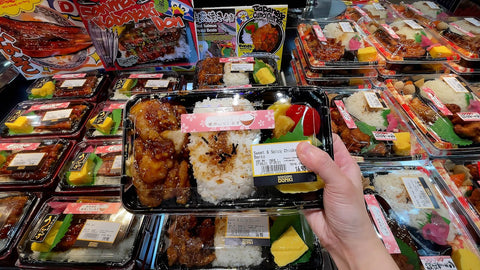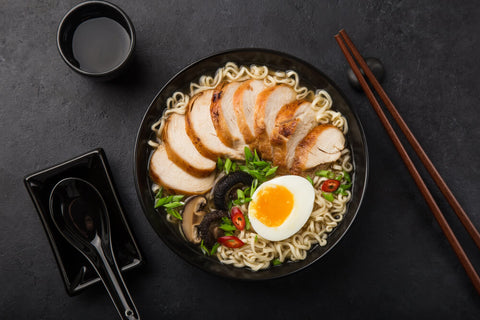5 Japanese healthy eating principles
Japanese cuisine is considered one of the healthiest cuisine in the world. That is also the reason Japan is one of the countries with the highest life expectancy in the world.
In a recent discovery, we had an interview with some nutrition experts and a few chefs to have an intensive view of Japanese smart diet. And here are 5 unique Japanese eating principles.
1. Principle "Hara-Hachibu"

Most of us are taught as a child is to eat all what is moved out, and not to be redundant, wasting food. But between the end of the meal before eating the last piece or trying to eat all, which one will be better?
For the first time when looking at a meal in a Japanese restaurant, one of the first thoughts of everyone is "it looks bigger in the picture." The size of the diets is much smaller than the dishes served abroad - this is a good point. The Japanese recommend that you eat Hara Hachibu (Hara Hachibun -ME) - eating about 80%. The amount of food on the plate is not scary; It allows you to enjoy the taste of food without having to be full. According to this principle, eating just enough and not making you feel uncomfortable later. Before eating the last piece, think that you really need to eat it. If you don't eat - then leave it.
2. Avoid ready food

Imagine that you go home at 9pm after a tiring working day, and spending 30 minutes for cooking makes you crazy. Instead, you choose processed foods in the supermarket and feel comfortable with not having to cook at night like that.
Stop if you want to eat healthy. These foods are mostly equivalent to fast food, and if you use this food for a long time, you will gradually feel depressed or gain weight after a few months. These foods contain a lot of oil and preservatives, so too much use will not be good for your waist as well as your health.
Limit shopping when hungry and avoid dinner when the supermarket starts to close, the discount of some food items can lead you to fried food, starch or a meal too much carb, no Help your health well even it makes your health gradually decrease over time.
Instead, why don't you prepare a nutritious dinner yourself for dinner before you leave home to work in the morning?
3. Pay attention to carb, sodium and sugar in meals

The three bad things in Japanese cuisine are carbohydrates, sodium and sugar. They only need a certain amount, and we need to be careful with them to have a healthy diet.
Most Japanese meals have soy sauce (containing sodium). Miso soup, the main food in many menus at Japanese restaurants contains a good amount of sodium, some other foods have nearly 1000mg of sodium.
Be careful about the amount of sodium and pay attention to your blood pressure if you or your family have a history of heart disease. When buying food at stores, read the ingredients carefully to help you determine the amount of sodium produced in the product.
Carbohydrates everywhere and even SOBA noodles are no longer safe because most Soba shops use instant noodles made of refined flour up to 60% instead of buckwheat. If you are trying not to add carb in your diet, Soba noodles (80% buckwheat, 20% of wheat mixture), or instant noodles from Konnyaku or Shirataki with lots of fiber is the choice the best.
Did you know that most Japanese dishes have a little sugar in one way or another to balance the flavor? When watching a Japanese home cooking program, and one thing is that the sugar is available in most sauces, stews, curry, some types of Karaage and even in Ramen.
So, if you are trying to control the amount of sugar, unfortunately you will have to sacrifice some true Japanese flavors.
4. Do not believe in the magical diet

Today, there are countless information on how to eat, as well as some healthy foods. For example, some diets such as bananas, black garlic, natto, umeboshi (ginger sauce), kimchi/yakiniku, and some other strange modes are different from promising that it will be a magical miracle.
But no expert advises you to eat a single food no matter how good it is. Tofu and green tea are often offered as a miraculous food abroad, but they are only part of the standard of the traditional diet, and their effects are almost miraculously as miraculously as People still praise if they eat it too much or almost only use them at a meal without using any other food. That leads us to principle 5.
5. The secret of diversity

The diversity in the meal will give you more healthy and have a slim body. If you've ever had the opportunity to enjoy a traditional Japanese meal at the hot spring or when you visit Kyoto, you can notice that there are many diverse and rich dishes.
A traditional Japanese meal is often made according to the principle of Ichijyu Sansai (a soup with three vegetables plus rice and fish) to ensure a good balance for the body and that is the key to a mode. Eat healthy Japanese.
Small meals have more than 15 different foods per day or even at a meal, including beans, seafood, vegetables, with a little rice, noodles or meat, they provide enough vitamins and vitamins and Minerals that the body needs.
For every meal of the day, try to eat each different type with a small amount of enough use.
